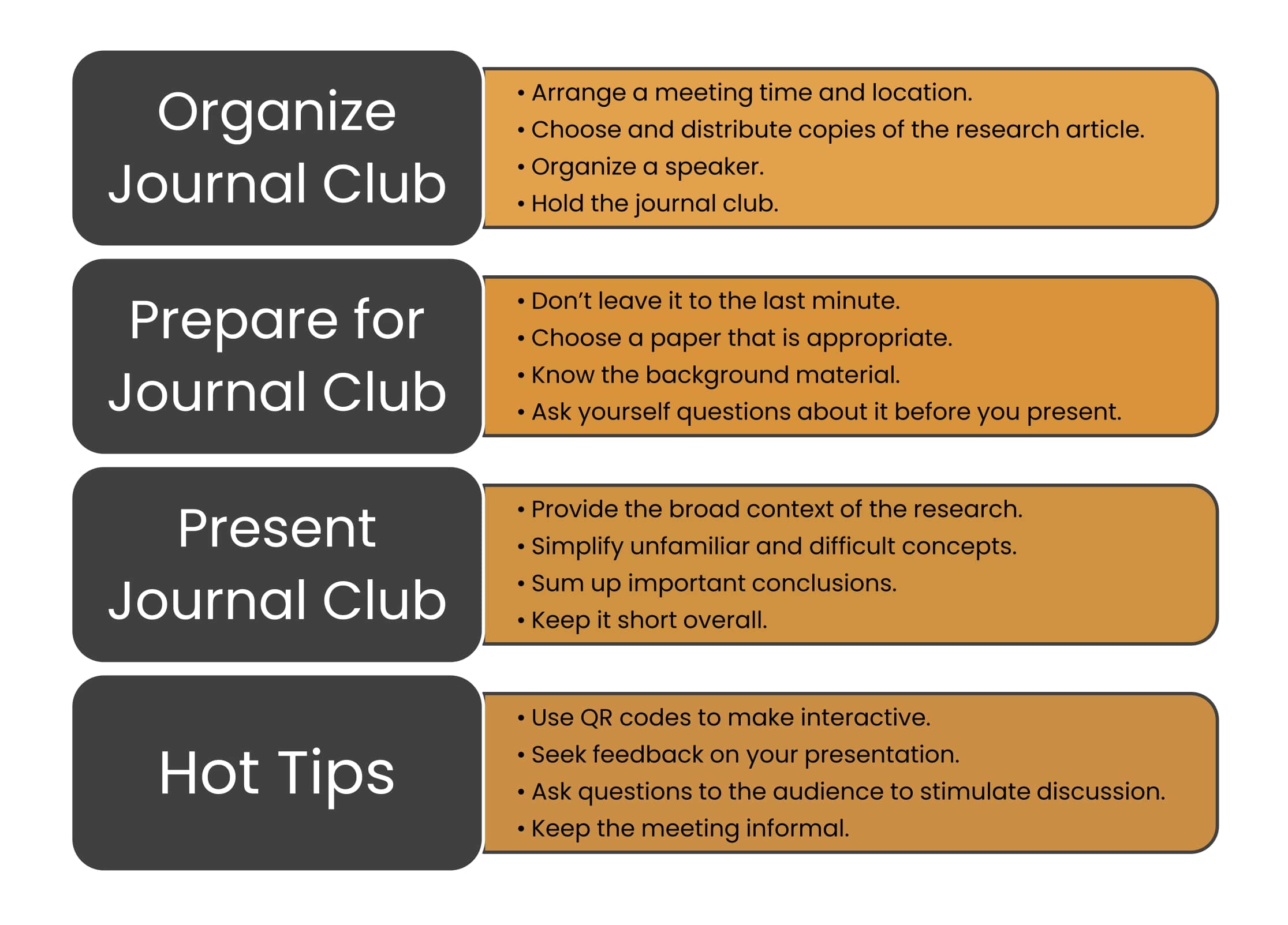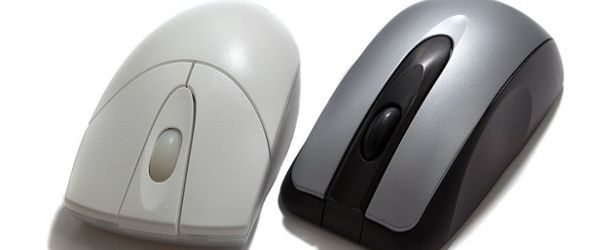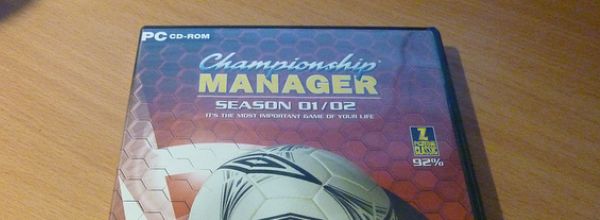Journal club. It’s so much more than orally dictating a paper to your peers.
It’s an opportunity to get a bunch of intelligent people in one place to share ideas. It’s a means to expand the scientific vocabulary of you and the audience. It’s a way to stimulate inventive research design.
But there are so many ways it can go wrong.
Poorly explained papers dictated blandly to an unengaged audience. Confusing heaps of data shoehorned into long presentations. Everybody stood awkwardly outside a meeting room you thought would be free.
Whether you are unsure what journal club is, are thinking of starting one, or simply want to up your presentation game—you’ve landed on the ultimate journal club guide.
The whats, the whys, and the hows, all in one place.
What Is a Journal Club in Science?
A journal club is a series of meetings in which somebody is elected to present a research paper, its methods, and findings to a group of colleagues.
The broad goal is to stimulate discussion and ideas that the attendees may apply to their own work. Alternatively, someone may choose a paper because it’s particularly impactful or ingenious.
Usually, the presenter alternates per a rota, and attendance may be optional or compulsory.
The presenter is expected to choose, analyze, and present the paper to the attendees with accompanying slides.
The presentation is then followed by a discussion of the paper by the attendees. This is usually in the form of a series of questions and answers directed toward the presenter. Ergo, the presenter is expected to know and understand the paper and subject area to a moderate extent.
Why Have a Journal Club?
I get it. You’re a busy person. There’s a difficult research problem standing between you and your next tenure.
Why bother spending the time and energy participating in a series of meetings that don’t get you closer to achieving your scientific goals?
The answer: journal club does get you closer to achieving your scientific goals!
But it does this in indirect ways that subtly make you a better scientist. For example:
- It probably takes you out of your comfort zone.
- It makes you a better communicator.
- It makes you better at analyzing data.
- It improves your ability to critique research.
- It makes you survey relevant literature.
- It exposes you and your audience to new concepts.
- It exposes your audience to relevant literature.
- It improves the reading habits of you and your audience.
- It gets clever people talking to each other.
- It gives people a break from practical science.
It also provides a platform for people to share ideas based on their collective scientific experience. And every participant has a unique set of skills. So every participant has the potential to provide valuable insight.
This is what a good journal club should illicit.
Think of journal club as reading a book. It’s going to enrich you and add beneficially to the sum of your mental furniture, but you won’t know how until you’ve read it.
Need empirical evidence to convince you? Okay!
In 1988 a group of medical interns was split into two groups. One received journal club teaching and the other received a series of seminars. Approximately 86% of the journal club group reported improved reading habits. This compares to 0% in the group who received seminar-based teaching. [1]
Journal Club Template Structure
So now you know what journal club is, you might wonder, “how is it organized and structured?”
That’s what the rest of this article delves into. If you’re in a rush and need to head back to the lab, here’s a graphical summary (Figure 1).

Nobody likes meetings that flounder around and run over time. And while I have no data to prove it, I reckon people take less away from such meetings. Here’s a basic journal club template that assumes you are the presenter.
Introduce the Paper, Topic, Journal, and Authors
Let your audience know what you will be talking about before diving right in. Remember that repetition (of the important bits) can be a good thing.
Introducing the journal in which the paper is published will give your audience a rough idea of the prestige of the work.
And introducing the authors and their respective institutes gives your audience the option of stowing this information away and following it up with further reading in their own time.
Provide a Reason Why You Chose the Paper
Have the authors managed to circumvent sacrificing animals to achieve a goal that traditionally necessitated animal harm? Have the authors repurposed a method and applied it to a problem it’s not traditionally associated with? Is it simply a monumental feat of work and success?
People are probably more likely to listen and engage with you if they know why, in all politeness, you have chosen to use their time to talk about a given paper.
It also helps them focus on the relevant bits of your presentation and form cogent questions.
Orally Present Key Findings and Methods of the Paper
Simple. Read the paper. Understand it. Make some slides. Present.
Okay, there are a lot of ways you can get this wrong and make a hash of it. We’ll tell you how to avoid these pitfalls later on.
But for now, acknowledge that a journal club meeting starts with a presentation that sets up the main bit of it—the discussion.
Invite Your Audience to Participate in a Discussion
The discussion is the primary and arguably most beneficial component of journal club since it gives the audience a platform to share ideas. Ideas formulated by their previous experience.
And I’ve said already that these contributions are unique and have the potential to be valuable to your work.
That’s why the discussion element is important.
Their questions might concur and elaborate on the contents of the paper and your presentation of it.
Alternatively, they might disagree with the methods and/or conclusions. They might even disagree with your presentation of technical topics.
Try not to be daunted, however, as all of this ultimately adds to your knowledge, and it should all be conducted in a constructive spirit.
Summarize the Meeting and Thank Your Audience for Attending
There’s no particularly enlightening reason as to why to do these things. Summarizing helps people come away from the meeting feeling like it was a positive and rewarding thing to attend.
And thanking people for their time is a simple courtesy.
How Do You Organize It?
Basic Steps If You Are the Organizer
Okay, we’ve just learned what goes into speaking at the journal club. But presenter or not, the responsibility of organizing it might fall to you.
So, logistically, how do you prepare a journal club? Simply follow these 5 steps:
- Distribute copies of the research article to potential participants.
- Arrange a meeting time and location.
- Organize a speaker.
- Hold the journal club.
- Seek feedback on the quality of the meeting.
Apart from point 5, these are fairly self-explanatory. Regarding point 5, feedback is essential to growing as a scientist and presenter. The easiest way to seek feedback is simply to ask.
Alternatively, you could create a form for all the meetings in the series and ask the audience to complete and return it to you.
Basic Steps If You Are the Speaker
If somebody has done all the logistics for you, great! Don’t get complacent, however.
Why not use the time to elevate your presentation to make your journal club contribution memorable and beneficial?
Don’t worry about the “hows” because we’re going to elaborate on these points, but here are 5 things you can do to ace your presentation:
- Don’t leave it to the last minute.
- Know your audience.
- Keep your presentation slides simple.
- Keep your audience engaged.
- Be open to questions and critiques.
Regarding point 1, giving yourself sufficient time to thoroughly read the article you have chosen to present ensures you are familiar with the material in it. This is essential because you will be asked questions about it. A confident reply is the foundation of an enlightening discussion.
Regarding point 3, we’re going to tell you exactly how to prepare effective slides in its own section later. But if you are in a rush, minimize the use of excessive text. And if you provide background information, stick to diagrams that give an overview of results from previous work. Remember: a picture speaks louder than a thousand words.
Regarding point 4, engagement is critical. So carry out a practice run to make sure you are happy with the flow of your presentation and to give you an idea of your timing. It is important to stick to the time that is allotted for you.
This provides good practice for more formal conference settings where you will be stopped if you run over time. It’s also good manners and shows consideration for the attendees.
And regarding point 5, as the presenter, questions are likely to be directed toward you. So anticipate questions from the outset and prepare for the obvious ones to the best of your ability.
There’s a limit to everyone’s knowledge, but being unable to provide any sort of response will be embarrassing and make you seem unprepared.
Anticipate that people might also disagree with any definitions you make and even with your presentation of other people’s data. Whether or not you agree is a different matter, but present your reasons in a calm and professional manner.
If someone is rude, don’t rise to it and respond calmly and courteously. This shouldn’t happen too often, but we all have “those people” around us.
How Do You Choose a Journal Club Paper?
Consider the Quality of the Journal
Just to be clear, I don’t mean the paper itself but the journal it’s published in.
An obscure journal is more likely to contain science that’s either boring, sloppy, wrong, or all three.
And people are giving up their time and hope to be stimulated. So oblige them!
Journal impact factor and rejection rate (the ratio of accepted to rejected articles) can help you decide whether a paper is worth discussing.
Consider the Impact and Scope of the Paper
Similar to the above, but remember, dross gets published in high-impact journals too. Hopefully, you’ve read the paper you want to present. But ask yourself what makes this particular paper stand out from the millions of others to be worth presenting.
Keep It Relevant and Keep It Interesting
When choosing a paper to present, keep your audience in mind. Choose something that is relevant to the particular group you are presenting to. If only you and a few other people understand the topic, it can come off as elitist.
How Do You Break Down and Present the Paper?
Know and Provide the Background Material
Before you dive into the data, spend a few minutes talking about the context of the paper. What did the authors know before they started this work? How did they formulate their hypothesis? Why did they choose to address it in this way?
You may want to reference an earlier paper from the same group if the paper represents a continuation of it, but keep it brief.
Try to explain how this paper tackles an unanswered question in the field.
Understand the Hypothesis and Methods of the Paper
Make a point of stating the hypothesis or main question of the paper, so everyone understands the goal of the study and has a foundation for the presentation and discussion.
Everyone needs to start on the same foot and remain on the same page as the meeting progresses.
Turn the Paper into a Progression of Scientific Questions
Present the data as a logical series of questions and answers. A well-written paper will already have done the hard work for you. It will be organized carefully so that each figure answers a specific question, and each new question builds on the answer from the previous figure.
If you’re having trouble grasping the flow of the paper, try writing up a brief outline of the main points. Try putting the experiments and conclusions in your own words, too.
Feel free to leave out parts of the figures that you think are unnecessary, or pull extra data from the supplemental figures if it will help you explain the paper better.
Ask Yourself Questions about the Paper Before You Present
We’ve touched on this already. This is to prepare you for any questions that are likely to be asked of you. When you read the paper, what bits didn’t you understand?
Simplify Unfamiliar and Difficult Concepts
Not everyone will be familiar with the same concepts. For example, most biologists will not have a rigorous definition of entropy committed to memory or know its units. The concept of entropy might crop up in a biophysics paper, however.
Put yourself in the audience’s shoes and anticipate what they might not fully understand given their respective backgrounds.
If you are unsure, ask them if they need a definition or include a short definition in your slides.
Sum Up Important Conclusions
After you’ve finished explaining the nitty-gritty details of the paper, conclude your presentation of the data with a list of significant findings.
Every conclusion will tie in directly to proving the major conclusion of the paper. It should be clear at this point how the data answers the main question.
How Do You Present a Journal Club Powerpoint?
Okay, so we’ve just gone through the steps required to break down a paper to present it effectively at journal club. But this needs to be paired with a PowerPoint presentation, and the two bridged orally by your talk. How do you ace this?
Provide Broad Context to the Research
We are all bogged down by minutia and reagents out of necessity.
Being bogged down is research. But it helps to come up for air. Ultimately, how will the research you are about to discuss benefit the Earth and its inhabitants when said research is translated into actual products?
Science can be for its own sake, but funded science rarely is. Reminding the journal club audience of the widest aims of the nominated field provides a clear starting point for the discussion and shows that you understand the efficacy of the research at its most basic level.
The Golden Rule: A Slide per Minute
Remember during lectures when the lecturer would open PowerPoint, and you would see, with dismay, that their slides went up to 90 or something daft? Then the last 20 get rushed through, but that’s what the exam question ends up being based on.
Don’t be that person!
A 10-15 minute talk should be accompanied by? 10-15 slides! Less is more.
Be Judicious about the Information You Choose to Present
If you are present everything in the paper, people might as well just read it in their own time, and we can call journal club off.
Try to abstract only the key findings. Sometimes technical data is necessary for what you are speaking about because their value affects the efficacy of the data and validity of the conclusions.
Most of the time, however, the exact experimental conditions can be left out and given on request. It’s good practice to put all the technical data that you anticipate being asked for in a few slides at the end of your talk.
Use your judgment.
Keep the Amount of Information per Slide Low for Clarity
Your audience is already listening to you and looking at the slides, so they have a limited capacity for what they can absorb. Overwhelming them with visual queues and talking to them will disengage them.
Have only a few clearly related images that apply directly to what you speaking about at the time. Annotate them with the only key facts from your talk and develop the bigger picture verbally.
This will be hard at first because you must be on the ball and confident with your subject area and speaking to an audience.
And definitely use circles, boxes, and arrows to highlight important parts of figures, and add a flowchart or diagram to explain an unfamiliar method.
Keep It Short Overall
The exact length of your meeting is up to you or the organizer. A 15-minute talk followed by a 30-minute discussion is about the right length, Add in tea and coffee and hellos, and you get to an hour.
We tend to speak at 125-150 words per minute. All these words should not be on your slides, however. So, commit a rough script to memory and rehearse it.
You’ll find that the main points you need to mention start to stand out and fall into place naturally. Plus, your slides will serve as visual queue cards.
How Do You Ask a Question in Journal Club?
A well-organized journal club will have clear expectations of whether or not questions should be asked only during the discussion, or whether interruptions during the presentation are allowed.
And I don’t mean literally how do you soliloquize, but rather how do you get an effective discussion going.
Presenters: Ask Questions to the Audience
We all know how it goes. “Any questions?” Silence.
Scientists, by their very nature, are usually introverted. Any ideas they might want to contribute to a discussion are typically outweighed by the fear of looking silly in front of their peers. Or they think everyone already knows the item they wish to contribute. Or don’t want to be publicly disproven. And so on.
Prepare some questions to ask the audience in advance. As soon as a few people speak, everyone tends to loosen up. Take advantage of this.
Audience: Think About Topics to Praise or Critique
Aside from seeking clarification on any unclear topics, you could ask questions on:
- Does the data support the conclusions?
- Are the conclusions relevant?
- Are the methods valid?
- What are the drawbacks and limitations of the conclusions?
- Are there better methods to test the hypothesis?
- How will the research be translated into real-world benefits?
- Are there obvious follow-up experiments?
- How well is the burden of proof met?
- Is the data physiologically relevant?
- Do you agree with the conclusions?
How to Keep It Fun
Make It Interactive
Quizzes and polls are a great way to do this! And QR codes make it really easy to do on-the-fly. Remember, scientists, are shy. So why not seek their participation in an anonymized form?
You could poll your audience on the quality of the work. You could make a fun quiz based on the material you’ve covered. You could do a live “what happened next?” You could even get your feedback this way. Here’s what to do:
- Create your quiz or poll using Google forms.
- Make a shareable link.
- Paste the link into a free QR code generator.
- Put the QR code in the appropriate bit of your talk.
- Done!
Use Multimedia
Talking to your audience without anything to break it up is a guaranteed way of sending them all to sleep.
Consider embedding demonstration videos and animations in your talk. Or even just pausing to interject with your own anecdotes will keep everyone concentrated on you.
Keep It Informal
At the end of the day, we’re all scientists. Perhaps at different stages of our careers, but we’ve all had similar-ish trajectories. So there’s no need for haughtiness.
And research institutes are usually aggressively casual in terms of dress code, coffee breaks, and impromptu chats. Asking everyone to don a suit won’t add any value to a journal club.
Your Journal Club Toolkit in Summary
Anyone can read a paper, but the value lies in understanding it and applying it to your own research and thought process.
Remember, journal club is about extracting wisdom from your colleagues in the form of a discussion while disseminating wisdom to them in a digestible format.
Need some inspiration for your journal club? Check out the online repositories hosted by PNAS and NASPAG to get your juices flowing.
We’ve covered a lot of information, from parsing papers to organizational logistics, and effective presentation. So why not bookmark this page so you can come back to it all when it’s your turn to present?
While you’re here, why not ensure you’re always prepared for your next journal club and download bitesize bio’s free journal club checklist?
And if you present at journal club and realize we’ve left something obvious out. Get in touch and let us know. We’ll add it to the article!
References
- Linzer M et al. (1988) Impact of a medical journal club on house-staff reading habits, knowledge, and critical appraisal skills. JAMA 260:2537–41







